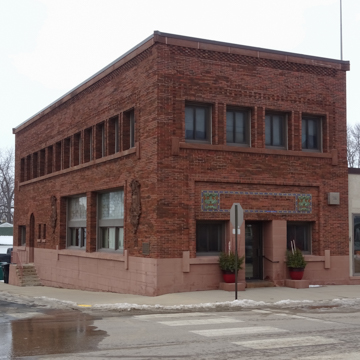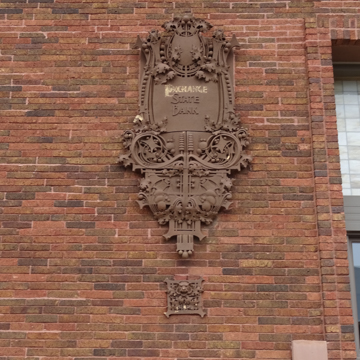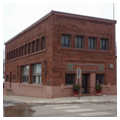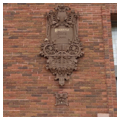You are here
First Farmers and Merchants State Bank
The Exchange State Bank in Grand Meadow was the first of three Mower County banks built by Purcell and Elmslie. It was inspired by the 1908 National Farmers’ Bank in Owatonna, Minnesota, which is typically credited to Louis Sullivan, although nearly all of the design work for the bank was done by Sullivan’s chief draftsman, George Grant Elmslie. The first of Sullivan’s “jewel boxes,” the bank featured an open floor plan and richly ornamented interior and was soon lauded in magazines and newspapers nationwide. When other small-town bankers began asking the bank’s vice president, Carl K. Bennett, about his architect, Bennett did not refer them to Sullivan (whose alcoholism had reached its nadir by 1907) but instead sent them to William Gray Purcell in Minneapolis. By April 1910, Purcell had convinced Elmslie to leave Sullivan and join him and his partner, structural engineer George Feick Jr., in business. With Elmslie on board, the new firm of Purcell, Feick and Elmslie was well positioned to design small banks. Ultimately, they produced designs for ten banks in Wisconsin, Minnesota, Nebraska, and the Dakotas.
The first of the Mower County banks, Exchange State Bank, completed in 1910, is located on the corner of Main Street and Grand Avenue in Grand Meadow. The two-story building contained the bank on the main level and rented offices on the second floor. It featured an open plan so that a single employee could watch the entire premises and run the banking business alone. Purcell described Elmslie’s design as a “clean, cubic mass of the building, the simple asymmetric composition of the long side [the Grand Avenue facade], but principally the absolutely unbroken and undisturbed march of the second floor windows from one end to the other. The old end-pavilions-and-center motive design system which had cursed architectural composition since the days of Louis XIV, were here demolished.”
In addition to the band of Prairie Style windows, Elmslie energized the Exchange State Bank’s dark red brick exterior with flourishes of terra-cotta. A rectangular frame of polychrome terra-cotta surrounds the bank’s name on the front facade and two large terra-cotta cartouches adorn the building’s long side. All of this is done in Elmslie’s highly Sullivanesque style, full of entwining tendrils, leaves, and seed pods. Elmslie also designed a sawn wood panel for a lunette over the building’s side door. All of these elements have been maintained and are in good condition, except that, unfortunately, when the bank’s name changed, a messy and unsuccessful attempt was made to eradicate the word “Exchange” in one of the terra-cotta cartouches. Though the interior has been completely renovated and contains little if any original material, the exterior is in very good and nearly original condition. It is now the First Farmers and Merchants Bank.
References
Millett, Larry. The Curve of the Arch: The Story of Louis Sullivan's Owatonna Bank. Minneapolis: Minnesota Historical Society Press, 1985.
Lathrop, Alan K., “Exchange State Bank,” Mower County, Minnesota. National Register of Historic Places Inventory-Nomination Form, 1975. National Park Service, U.S. Department of the Interior, Washington, D.C.
Purcell, William Gray and George Feick, Jr. to Carl K. Bennett, April 13, 1910. William Gray Purcell Papers (N4), Northwest Architectural Archives, University of Minnesota Libraries, Minneapolis, Minnesota.
Purcell, William Gray. Parabiography for 1910. Unpublished manuscript, c. 1950. William Gray Purcell Papers (N4), Northwest Architectural Archives, University of Minnesota Libraries, Minneapolis, Minnesota.
Writing Credits
If SAH Archipedia has been useful to you, please consider supporting it.
SAH Archipedia tells the story of the United States through its buildings, landscapes, and cities. This freely available resource empowers the public with authoritative knowledge that deepens their understanding and appreciation of the built environment. But the Society of Architectural Historians, which created SAH Archipedia with University of Virginia Press, needs your support to maintain the high-caliber research, writing, photography, cartography, editing, design, and programming that make SAH Archipedia a trusted online resource available to all who value the history of place, heritage tourism, and learning.

















